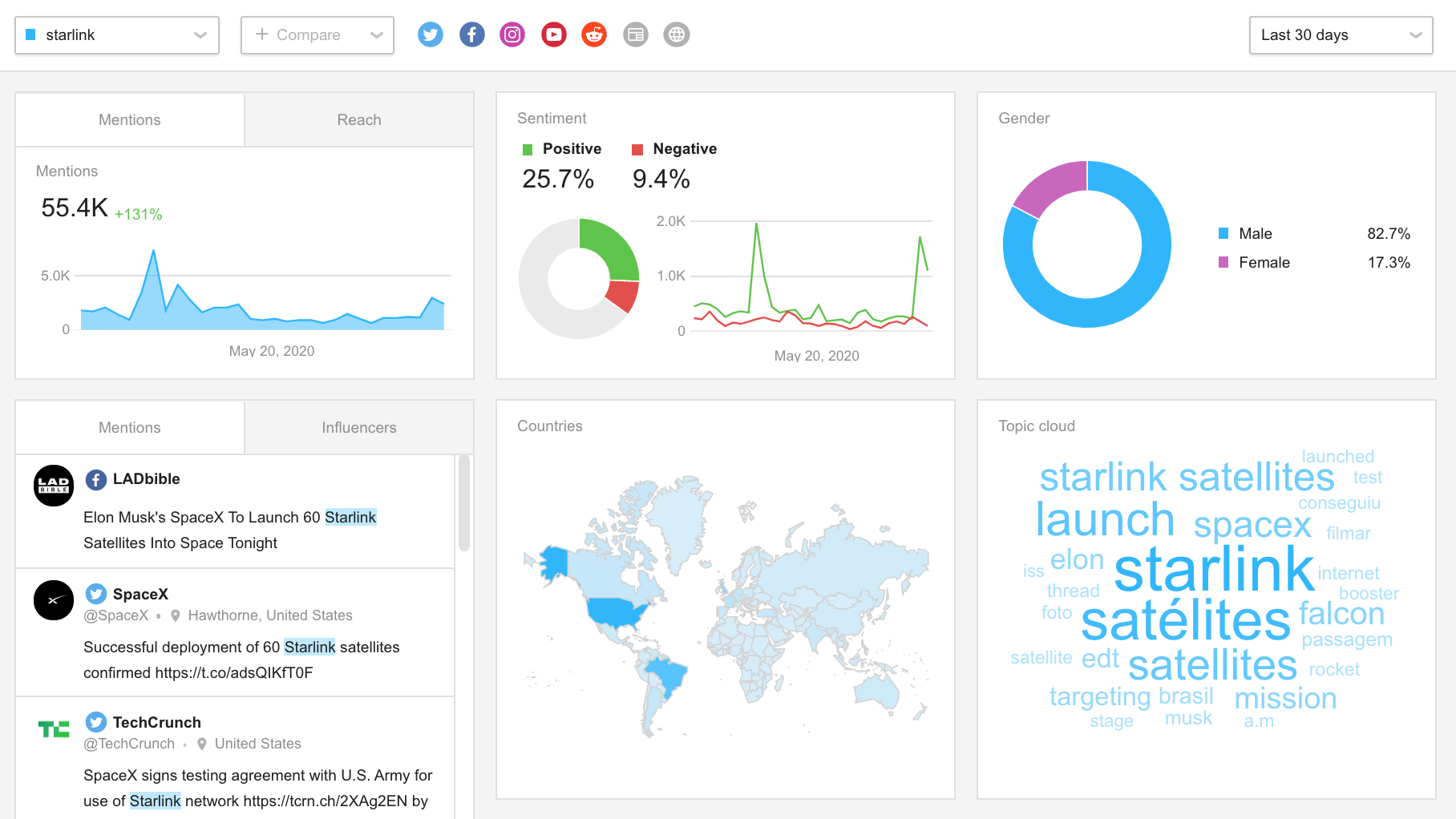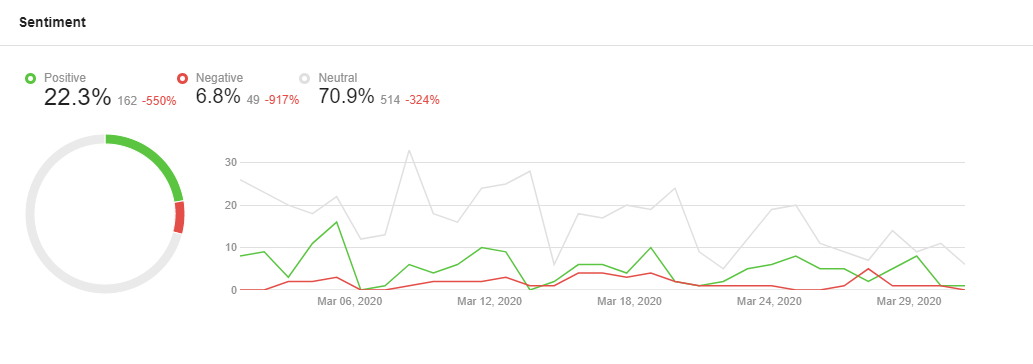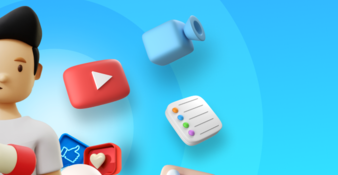7 things to look for in a social listening tool

So you’ve finally read enough marketing articles to realize that yes, yes, you need a social listening tool.
If you feel worried, I can reassure you: choosing a social listening tool won’t be the daunting task you imagine it to be. To make it as easy as possible, I’ll tell you what to look for in a social listening tool. This will leave you with enough options to choose from, as the social listening market is alive and booming, but you'll know what to focus on among the ads and vague benefits the marketers are throwing at you, and your search will become easier.
But first, we'll start with the basics - just in case.
What do social listening tools do?
Social listening tools crawl the Internet for mentions of your brand, product, name, or any other keyword. The depth and diversity of the coverage depend on the tool. Best tools cover everything: social media networks, blogs, forums, news sites, comment sections, and web sites. Some even cover print, TV, and radio, but these cost a fortune and are an overkill for most businesses.
Social listening tools find mentions in real time (some also return historical mentions) and collect them in a mentions' feed. There, you can go through mentions, reply to them, filter them by different attributes, and otherwise work with what your online presence turns out to be.
Later, after the tool has gathered a substantial number of mentions, these mentions are analyzed to show you the big data results. Social listening tools have different levels of analytics, but all of them serve the purpose of showing you your online presence objectively and at a glance. Instead of focusing on single mentions, analytics shows the overall growth, attitude, demographics, etc.

Once your alert is set up and the search is ongoing, the analytics is updated in real time, and you can see how the results are changing depending on your actions, the actions of your competitors, external influence, and so on.
What to look for in social listening tools?
1. Boolean search
In most social listening tools, you start the search using the "wizard": you type in your keywords and the tool searches for mentions of these keywords online.
But what if your brand name is a common word, such as "Apple", "Orange", "Forever 21"? What if punctuation in it matters, such as with "more & more"? What if there are specific requirements that you have for your query? For all of these, and for many more cases, you need to look for a tool with a Boolean search option. It will allow you to manually create a query and specify the search so that you get only relevant results.

Using Boolean search requires some reading and some practice, but it's pretty easy anyway and requires no special programming skills.
Why is it so important?
The biggest problem the users of social listening face is getting flooded with the online buzz and irrelevant information. Boolean search is the only way to handle this problem.
2. Coverage
As noted in the introduction, social listening tools have different levels of coverage. This is definitely something to look at when choosing a tool.
If you plan to use the tool to its fullest potential, choose one that covers major social media platforms, news, blogs, and forums. For most social media marketing goals, you don't need to search through other websites, but you need all "social" platforms to analyze the level of conversation around your brand, people's attitude to your brand, as well as to perform competitor analysis, which is an incredibly useful analysis for any marketer, and to carry out constant and outstanding customer service.
3. Sentiment analysis
Sentiment analysis is one of the most useful features a social listening tool can have. Sentiment analysis breaks down all your mentions into positive, negative, and neutral to show you the overall brand (or personal) reputation, and how it changes over time.

With sentiment analysis, you can see what you're doing right and wrong in terms of product launches, marketing campaigns, and features. It's a much more reliable way to find out what your target audience really thinks about you, as unlike questionnaires responders and members of focus groups, social media users are not prone to social desirability bias.
Sentiment analysis is also very useful for customer service: it lets you filter all mentions by sentiment and reply to negative mentions first.
4. Insights
The insights feature (can be called differently) is part of the analytics. It's responsible for showing you any unusual activities in your mentions. It lets you see at a glance if something needs your attention: if there is a spike in the number of mentions, in their reach (this means someone famous has mentioned your keyword), or a sudden change in sentiment. This is especially useful if there is a social media crisis unfolding. In fact, for anyone taking care of reputation, the insights feature is a must.

5. Demographics
Demographics is important when finding out who your real target audience is. Often, we make a mistake of imagining a perfect buyer persona that has nothing or very little in common with the people who actually talk and buy our products. Most marketing tools and social media platforms reveal the demographics of the people who follow/purchase/go to your website/etc. It's best if a social listening tool does that too so that you know which demographics (gender, age) talks about you online and, therefore, who you should target.
6. Reporting
Social media marketing is a rather vague field. It's often hard to prove to your boss (and sometimes, even to yourself) that social media marketing brings real results and that all this effort is not just a waste of time. Reporting is a feature that does this for you. If shows how your brand awareness has grown, how many more positive things people have said after the latest event, and what the effect of your influencer marketing campaign was. All of it - on social media. Social media is where growth, attitude, and popularity happens, and social listening tools show exactly that.
7. Cost
All of the above is surely important. But the fact is, many social listening tools are incredibly expensive. So, definitely, look at the cost before purchasing, and calculate possible ROI. You don't really need me to tell you this, but I will do this anyway.
Besides...
All social listening tools have either free trials or demos. Try before you buy - in fact, try a couple before you buy, because it's important to find a tool you intuitively like. After all, you'll probably use it a lot and look at it a lot, and it's important you like what you're looking at.
To get you started, here is the list of best social listening tools according to Social Media Today.
By signing up I agree to the Terms of Use and Privacy Policy













